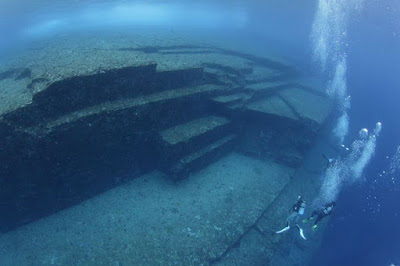 |
| The Yonaguni Monument, 30 meters underwater, Japan. Source. |
An Ultra-Brief History of Humanity
The belief that we can find the true story of pre-history underwater is based on two main ideas:
We are taught that we first entered the Neolithic Era at approximately 10,000 BC. The Neolithic Era describes the period where humans began transitioning from hunter-gatherer-wanderer communities to more stable settlements, agriculture, and domesticated animals. In essence, this is when the first cities began.
Assuming the traditional model of human evolution, the first homo sapiens emerged approximately 200,000 years ago. This is disregarding previous ‘homo’ species, which actually already had fire and stone tools for tens of thousands of years before homo sapiens evolved.
In just 12,000 years, (or 3 million years, if we include the previous ‘homo’ species that came before us,) we transitioned from the Stone Age to landing on the moon. Are we to then assume that it took the previous 188,000 years, to transition from being bipedal apes to using simple tools? In case you’re having a hard time imagining the scale of those years, here’s how it would look on a timeline. (Click to enlarge.)
 |
| An Ultra-brief Human History Timeline. |
But, if there were previous civilizations that were as advanced as us, shouldn’t there be proof? Well, that brings me to my next point.
Human History and our Love for Water
Below, you’ll see a current map of the world which is colored based on population density. As you can see, dense populations tend to thrive along the coast. This is for multiple reasons, such as fishing, trade, and pleasant sea breeze. All that is beside the point though. The image speaks for itself. |
| The world, by population density. Source. |
 |
| An Ice Age world map. Source. |
So what’s the point of this?
Rising Sea Levels – What does it mean for us?
This next image shows a “before and after” of our last Ice Age. The areas in green being our current land, and the areas in brown representing previous land that is now submerged.
 |
| The Ice Age. Source. |
The last Ice Age ended about 11,700 years ago. This basically meant large amounts of melting ice, and ocean levels rising by approximately 100 meters. If there was an advanced civilization before us: Atlantis, Lemuria, Mu. Well, now you know where they are. Maybe it wasn’t a complete fairy tale to say that they were swallowed by the sea.
On a side note, note the date: Maybe it isn’t such a coincidence that our “first cities” began just 10,000 years ago.
Underwater Cities Found!
Carrying on with the same theme, here are just a few things that we have discovered underwater so far. Let us remember that cities do not simply sink into the sea. If a city is found underwater, the first question should be: Why? (and after that, when?)
The Yonaguni Monument, Japan.
 |
| The Yonaguni Monument, 30 Meters underwater, off the coast of Japan. Source. |
The Gulf of Cambay, India
 |
| The sun shines on the Gulf of Cambay, India. Source. |
Those are just two of so many underwater cities that have been discovered. The discovery of an underwater city means so much more than just a city that has sunken into the sea. Cities don’t just sink into the sea. Underwater cities change the entire model of human history and everything we think we know about our “origins.”
So many underwater structures have been discovered, including the outrageously old Rama Bridge and the Pyramid at the center of the Bermuda Triangle. If these things are truly man-made, it very literally changes everything we think we know.
We don’t know much about our underwater pre-history at the moment, but for the ones that we do find, it means a lot more than we think. It’s not whether or not the stories of Atlantis were true. In fact, forget Atlantis. That is not the point here.
The point is that history did not start 12,000 years ago. It restarted 12,000 years ago. Evidence of that is all around us. Just off the coast.


Great article !!
ReplyDeleteThanks! :D
Delete